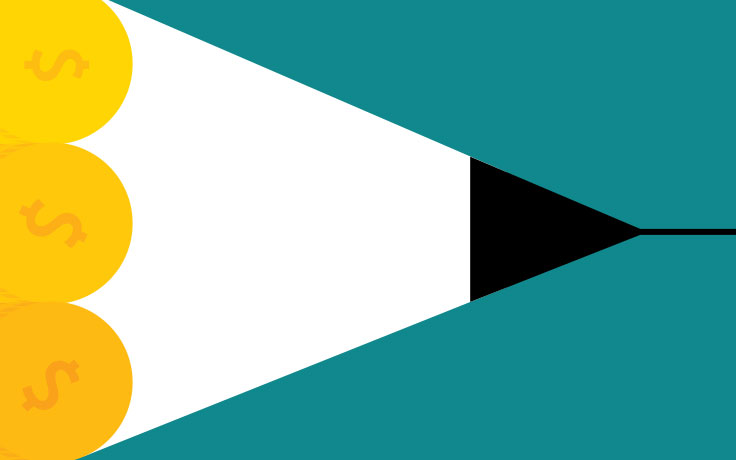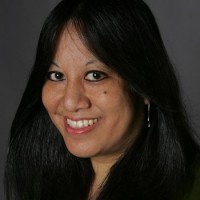GROWING UP IN SANTA FE, N.M., Meredith Phillips attended a socioeconomically diverse middle school where she lived what would later become the focus of her studies.
“I got a taste of what education looked like for kids who were treated as though they didn’t deserve a good education. You’d mostly see white kids from advantaged backgrounds in the top tracks and Latinos and Native Americans from disadvantaged backgrounds in the lower tracks,” said Phillips, an associate professor of public policy and sociology at UCLA. “It gave me a sense of privilege and disadvantage and inequality — and it stuck with me in a visceral way.”
Today, Phillips is an educator and researcher who has taken portions of what she has learned over the years about inequities in education and turned them into the EdBoost Learning Center — a philanthropically funded nonprofit.
Located in Palms, on the upper level of a nondescript strip mall next to an insurance office and above a small market and a barbershop, EdBoost offers tutoring services, homework help, SAT prep courses and college counseling to a diverse range of students in kindergarten through 12th grade. Unlike many learning institutions, the center also serves as an incubator for developing new programs and interventions designed to close education gaps among children from different socioeconomic and ethnic backgrounds.
EdBoost is the brainchild of Phillips and her former graduate student Tiffani Chin, who serves as its executive director. Founded in 2004, the center sprang from a desire by Phillips and Chan to move beyond the constraints of statistical research and put their findings into action to help kids.
Phillips has spent much of her career studying inequities in education and academic achievement. Her early research examined how these disparities change over time as children grow older. “To what extent were schools in some ways responsible for these achievement gaps, and to what extent [were] other factors in kids’ lives were responsible?” she said. “I’m a sociologist, so I was really interested in the relative contributions of different environments — neighborhoods, families, schools — to kids’ outcomes.”
She found that signs emerged early in children’s lives. “You can see disparities in kids’ vocabulary skills as early as you can measure vocabulary — that’s certainly by age 3, but probably earlier,” Phillips said. “Some disparities are smaller than you might think; some of them are about what you may think. But there’s no doubt that richer kids on average get to go to schools that, as best we can tell, seem better.”
Her widely cited 1998 book, “The Black-White Test Score Gap,” co-edited by Harvard professor Christopher Jencks, compiled research — including her own – that found disparities largely tied to home life outside of school or preschool. It concluded that changing how parents deal with children may be the key to improving achievement. A follow-up paper by Phillips found that by age 6, children of high-income parents have spent an average of 1,300 more hours in enrichment activities than those of low-income parents.
“It’s clear people care about their kids, and they want them to do well,” said Phillips, 48, who is married and the mother of two. “You think about social class and socioeconomic status — there are big disparities. They’re there before kids start school. So part of the puzzle is, what do you do? Are you better off intervening when kids are little? Before they hit school or right when they hit school? That’s part of what I’m interested in.”
From biology and literature to education
Phillips didn’t start by looking for ways to close the gap in education achievement, or even by teaching. At Brown University, she majored in human biology and Latin American literature. Through the support and encouragement of a professor, she went to graduate school at Northwestern, where she entered a human development and social policy program, later adding sociology.
“When you apply to graduate programs, you’re supposed to write about what you want to do your research on, what you’re interested in. I didn’t know what I wanted,” she said, laughing. “So I wrote my essay on resilience — what makes kids resilient? Why do many kids from difficult backgrounds and challenging circumstances succeed?”
Thinking she would eventually get a job leading a nonprofit organization, Phillips began taking classes in research methods and statistics — tools she thought would be useful in the nonprofit world. But professors and others kept telling her: “You should be a professor. You should be an academic. You’re really good at this.”
“I think about that for little kids — this idea that you have people who see something in you and recognize it and encourage it,” she said, sitting in her sixth-floor office overlooking the UCLA campus. “I don’t think without the good teachers I’ve had I would be where I am now.”
After years of studying education inequities, Phillips decided she wanted to go beyond just describing achievement gaps and disparities. “I started feeling like I’d at least like to do something to try to help kids.”
The pioneering work of EdBoost
Around that time, Phillips met Chin, a doctoral candidate in sociology who attended a talk the professor gave on parenting practices and academic achievement. Chin ended up taking classes with Phillips and later asked her to co-chair her doctoral committee. “She was someone who is just far more open-minded about research than anyone I had ever met … and was deeply interested in trying to find a way to answer questions, and caring about kids,” Chin said.
The two collaborated on research examining children as they transitioned from elementary to middle school. “I spent a year embedded in a fourth-grade class, following the kids home, going to activities and doing all this crazy stuff,” Chin said.
For Phillips, the mixed-method study was a chance to return to the ethnological side of her training while still doing the surveys, interviewing and data-driven research she was accustomed to. Her voice becomes more animated as she talks about getting back into the field. “It’s really tough as a researcher once you start getting into the qualitative research because you’re spending time with real people. When people are just statistics in your computer, they’re not there — you couldn’t help them in any way. You can see disparities; you can describe them. But it’s different when you’re hanging out with kids and talking with them a lot.”
As an informal research experiment, Phillips and Chin put on a summer academic enrichment camp. “We were curious,” Phillips said. “Kids had stuff to do in the yard, but if we offered science classes, would they be interested? Would they want to participate if it was there?”
They did. In fact, they lined up for the sessions. So the following summer, Phillips and Chin offered another enrichment program. Just over a year later, they launched EdBoost.
“The idea was that you would serve kids in this learning center or out in the real world, but at the same time we would be trying to develop effective ways to educate kids,” Phillips said. “So we are trying out curriculum or trying out tutoring programs or different ways of helping kids learn a particular skill and [will] later try to implement the programs somewhere else.”
EdBoost began with just three students. It has since grown to more than 200 at the center and another 300 through offsite programs. Services at the center are offered on a sliding scale; prices are set at market rate for upper middle-class parents, while kids from more economically disadvantaged backgrounds can apply for need-based scholarships.
“We planned it this way — that the richer people sort of subsidize the others,” Phillips said. “We wanted to make sure that we were providing stuff that people who had the ability to go anywhere for would value enough that they would come to EdBoost.”
Tutors don’t know if they’re working with scholarship or full-paying kids, Chin said: “That’s what makes me proud of this place. When we talk about trying to cut down on inequality, it’s not by providing poor kids with some poor version of what rich kids get. It’s by trying to provide them with exactly what rich kids get. They’re getting the exact same thing.”
Edboost, which is subsidized by grants and contracts, has three full-time employees and about 20 tutors. It doesn’t advertise; most children find the center through word-of-mouth. In addition to developing a series of diagnostic tests to help determine gaps in math comprehension and a reading-writing program designed to help improve comprehension, fluency and vocabulary, Phillips and Chin worked together under the auspices of EdBoost to research college access interventions for low-income students. Phillips served as a consultant for the first study, SOURCE, or Student Outreach for College Enrollment, which focused on various levels of assistance for juniors and seniors with preparing college applications.
Students in randomized field tests were assigned to advisers who met with them and provided information and assistance on the college application process. The second group was not assigned advisers and relied only on information they received at school, at home or elsewhere.
“We were targeting low-income schools because there is still evidence that even among kids who are ready academically for college and have strong academic achievement, low-income kids are less likely to go to four-year colleges than rich kids,” Phillips said.
Taking what they learned from that study, they revised and reshaped the program a few years later. Through a grant to EdBoost and UCLA, Phillips and Chin, along with Sarah Reber, an associate professor of public policy, launched V-SOURCE, in which all of the counseling is done virtually. By eliminating in-person interaction, costs decreased and it became easier to serve outlying communities where students do not have easy access to college advisers.
A third of the students were assigned advisers who communicated with them by phone, text, email, Facebook and other social media platforms.They also received automated emails. A second group received only the automated emails. The final group received no assistance from EdBoost. Phillips and Reber are currently evaluating the results of the research, which is the first randomized trial of an entirely virtual intervention designed to assist students with the college process.
Partnering with LAUSD
Most recently, Phillips has taken on what may be her biggest project. In 2009, she approached officials at the L.A. Unified School District to see if they would be interested in forming a research-practice partnership with UCLA. Similar partnerships exist in Chicago, Baltimore, New York and Houston.
“I wasn’t sure if this would develop into anything,” Phillips said. “I had this idea — what kind of information do we need or what kind of research would be useful to people trying to make schools better or trying to decide what to do at the district level to help the schools get better?”
She enlisted Kyo Yamashiro, an associate professor at Claremont Graduate University’s school of educational studies, and founded LAERI, the Los Angeles Education Research Institute, which tracks how many high school graduates go on to four-year colleges and complete their degrees. The researchers take administrative data already collected by LAUSD and analyze it to help the district find ways to improve academic success.
Interim results drew wide notice last summer; they found that 68% of 2008 LAUSD graduates enrolled in two- or four-year colleges, but only 25% graduated within six years. An initial look at college readiness among LAUSD students found that while information about course requirements, college eligibility and financial aid was available, some students lack adequate support and counseling assistance — largely because of heavy caseloads and other demands on counselors.
“I think what is difficult about education is that everybody had an education. So everybody has an opinion based on their personal experience in education that sort of frames how all of us think,” Phillips said. “It’s all very personal in a way that other kinds of policymaking aren’t.”
But she remains hopeful.
“Achievement gaps have shrunk over time from when I first started studying disparities between African American kids and white kids. They seem smaller than they used to be. It’s not that hopeless,” Phillips said. “Aspirations are high. That’s not a problem. The problem is getting them to realize their aspirations.”

























